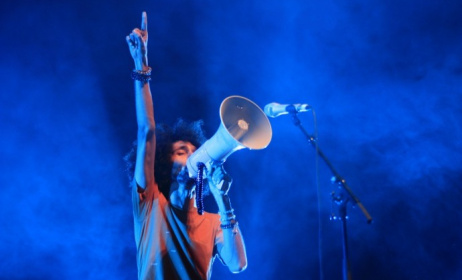Adam Chienjo: Reshaping the Kenyan dance narrative
For Adam Chienjo dance has always been more than a passion. “It is a lifestyle,” he tells me when he finally manages to squeeze in a few precious minutes out of his busy schedule. It’s just three days to the Dance Life Festival and as its curator Chienjo has little time for respite.
 Kenyan dancer, choreographer and Dance Life Festival curator Adam Chienjo.
Kenyan dancer, choreographer and Dance Life Festival curator Adam Chienjo.
The event, which took place at the Kenya National Theatre in Nairobi on 30 and 31 July, has been years in the making, but it came alive in the most unexpected of ways...
It had been close to four years since Chienjo pitched a dance event idea to Goethe-Institut Nairobi and then came the COVID-19 pandemic. As was the fate of most artists at the time, the dancer was left staring at uncertainty, not knowing when he would ever return to doing what he loved doing. Then one day, at the height of the pandemic, Chienjo received a call from Goethe-Institut – they wanted him to help organise a dance showcase, more or less like the one he had proposed.
Given that the country was still in the grip of tough COVID-19 restrictions, it meant that the first edition had to be held virtually. It nevertheless produced the desired effect, with an impressive number of people signing up for the online classes that preceded a successful virtual concert. The second edition exceeded all of Chienjo’s expectations when hundreds of people attended an in-person performance at the Goethe-Institut auditorium.
“In 2021, we were just about to hold the second show when another ban on public gatherings was imposed and we had to postpone until a later date,” he said. “When we finally managed to do it, I was pleasantly surprised. To see a theatre full of people coming to see contemporary dance was a bit of a shock to me. We normally have a small expatriate-based audience but this time there were many locals showing interest.”
Now that the third edition has ended with a flourish, Chienjo gives us the real story behind the Dance Life Festival. “I wanted to reactivate the dance scene in Nairobi. I started dancing professionally around 2000 with the Safari Cats, which was probably the only dance company at the time. But gradually I noticed that the expressive and interpretative elements were lacking. There were people interested in the contemporary dance genre but there was no platform to showcase or even train. When Goethe-Institut finally got back to me, I was able to implement this.”
For someone who is completely immersed in dance, it is easy to see why he lights up when describing the art form. “For me, dance has always been a lifestyle. It is a career. I teach and I critique. It’s like breathing because every culture has dance. Dance can be used in many ways. It is therapy in that it helps express things that you cannot verbalise. Dance is a vocabulary of movement that is easy to use because it is relatable.”
With the festival incorporating workshops and dance film screenings, it is able to do more than just entertain an audience. The ‘artist’ is now at the heart of it. And the fact that no single performer has been featured twice since the festival’s inception speaks of the abundance of local talent.
“The workshops allow us to talk to professionals from different genres – ballet, traditional, jazz, seben, Afro-fusion, ragga, tap, you name it,” Chienjo says. “This time we had four choreographers leading the workshops, and new dancers were able to learn from their experiences.
“I acquired dance techniques and training modules through workshops, both here and abroad. That is why I am trying to create the same environment for upcoming dancers and a space for the established ones to interact and stimulate creativity.”
Artists who showcased their work at this year’s event included Neema Bagamuhunda, whose piece confronts the pursuit of fleeting values like money and fame and their impact on mental health and human connections. Another was Brian Oloo who presented a riveting dance duet that combines different styles of contemporary dance into something wholly unique and dynamic.
The Swiss-Brazilian choreographer Luanda Mori, who over the past 20 years has been developing educational and artistic work in which she explores the symbolism of movement as a sacred body language from a contemporary perspective, also had audiences transfixed.
Chienjo says the festival has been able to “reclaim tap dance”, which was appropriated by the West from Africa. “I am excited about tap dance because local kids are learning how to tap. Tapatapa, a tap dance company, was started from the workshops we held. I am happy to see that tap dance doesn’t seem like a foreign concept anymore.”
But what pleases Chienjo the most is the fact that he has been able to achieve his twin objectives: to see more women participating in dance and to showcase Africa’s cultural heritage through traditional troupes like Ntimaru Nyagetari, which performed at this year’s event. The festival is also slowly but surely starting to “go international” with the presence of choreographers from abroad.
“I thank Goethe-Institut for believing in me and getting the ball rolling. Other people want to be part of our story now and we’re hoping to bring in new partners for the upcoming events,” Chienjo said.






























Commentaires
s'identifier or register to post comments